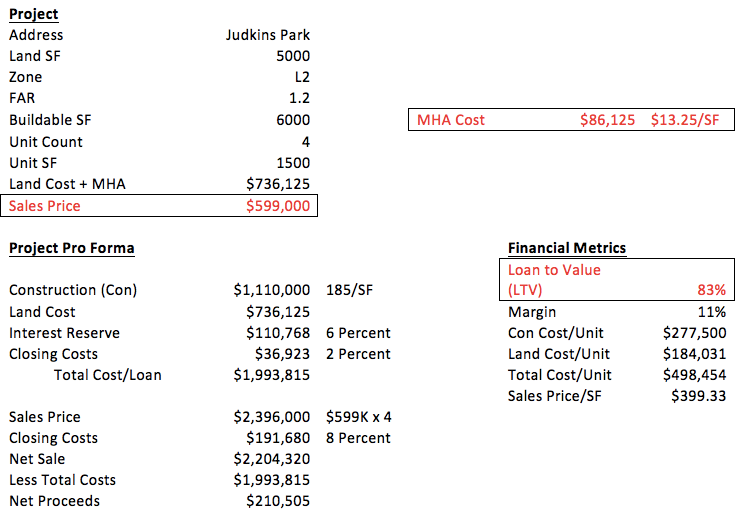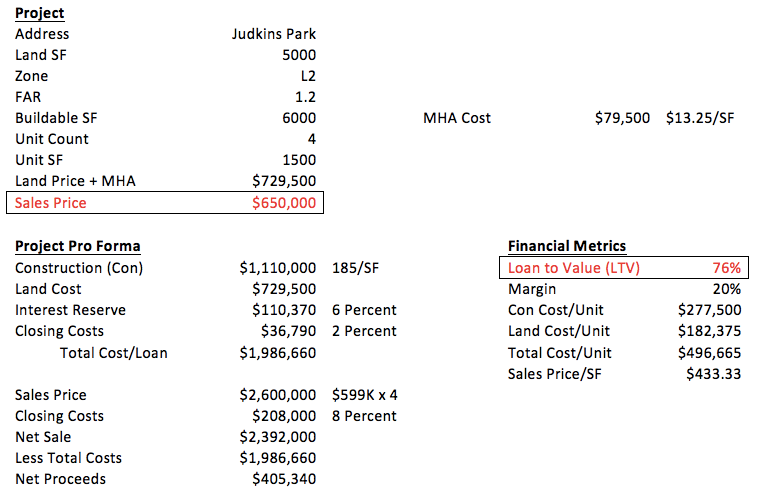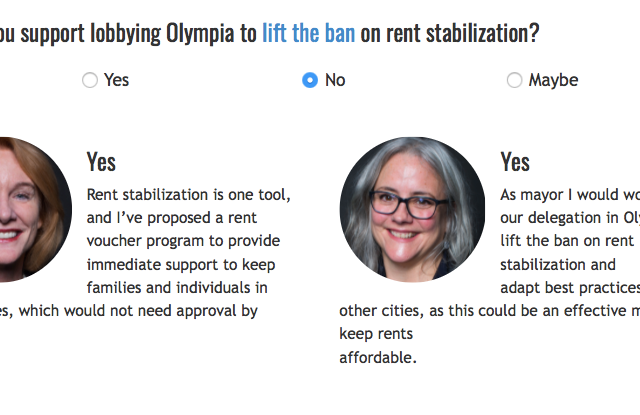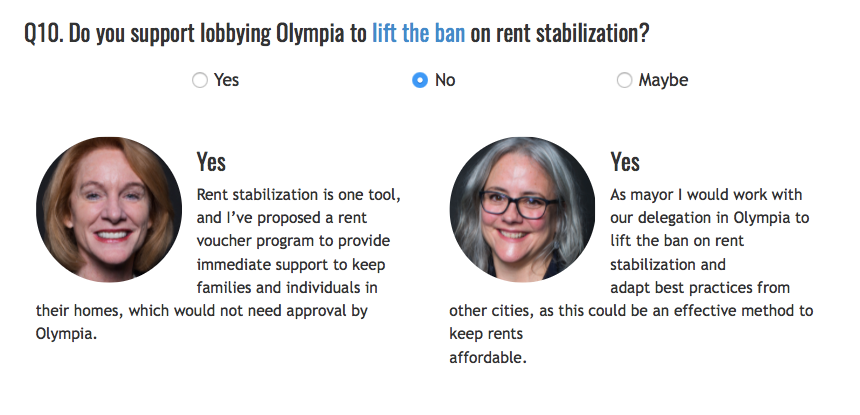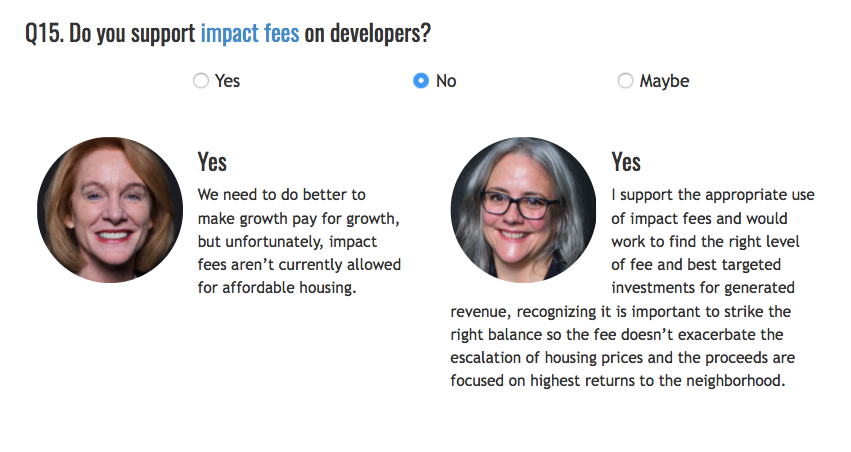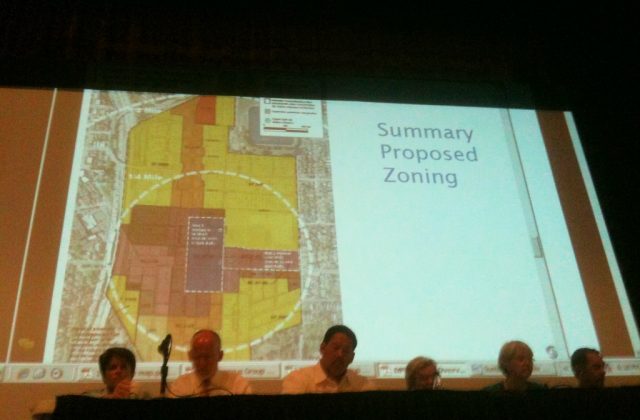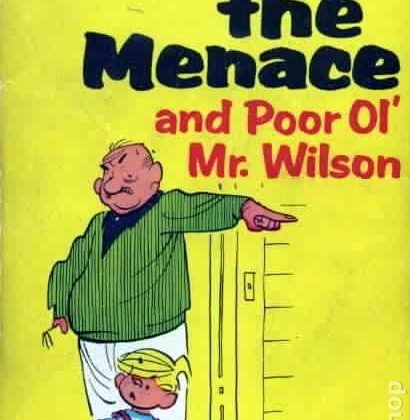I’m Telling You for the Last Time: Candidate and Voter Primer on the Wrongness of MIZ
Repetition is a powerful rhetorical device. Think of music or poetry especially, but also visual art. A phrase or lyric is often repeated in order to create an impact. Think of Dylan Thomas’ poem, “Do not go gentle into that good night,” a poem that if you remember it all is remembered for the repeated phrase, “rage, rage against the dying of the light!” Politics is about repetition too. Practitioners of political warfare know that the number of times you see a candidates name and here their “message,” usually boiled down to a catch phrase, correlates strongly with how you’ll vote. And we also know that repeating something makes the idea stick. This is true of Seattle’s discussion over Mandatory Inclusionary Zoning.
Over the last year I’ve seen the Wallingford neighborhood suggest that “HALA upzones” are a developer giveaway. When I spoke with John Fox after a radio show, he was shocked to find that that wasn’t true. Most people who build, finance, and manage housing in the city don’t like the City’s forced auction of square footage. Yet most angry neighbors think that somehow builders want a tiny boost in square footage because, I guess, they think it means builders will “laugh all the way to the bank.”
Supporters of the “HALA upzones” also keep repeating the same thing. This, they say, is an innovative way of increasing density and creating more housing. See, the City grants more density and all the developer has to do is pay into a fund for more subsidized housing or include the housing in the development. Everyone wins! But it’s pointed out that there is no fair exchange of value with MIZ. It doesn’t work. It will make lots of projects infeasible because the costs of building more and the fees cancel out any benefit. That means less supply and higher prices, and when prices get high enough, the extra costs then get absorbed by higher prices and rents.
So, here I go again. What I keep finding is that many builders, developers, and real estate professionals still believe that they’ll only pay on the additional square footage. Nope. Every square foot of new housing and commercial development will be taxed — a lot. I posted this a while ago, but I am going to repeat it here since the so called “HALA upzones (this formulation drives me crazy: HALA was 64 recommendations only one of which were upzones associated with the Grand Bargain)” are a hot topic in the closing weeks of the election here’s a primer on why MIZ is a mess.
What’s Wrong With Mandatory Inclusionary Zoning/Mandatory Housing Affordability
Background: The Mandatory Housing Affordability (MHA) program is a form of Mandatory Inclusionary Zoning (MIZ), a change to the land use code that requires all new development to include rent restricted housing or pay a fee in lieu of that inclusion along with small increases in height. Seattle’s program was created as part of negotiations between a few larger market rate developers, non-profit developers (who get the fees), and representatives of the City of Seattle.
We weren’t invited: Representatives of the wider development community were left out of the process of negotiating the specifics of the MHA program. The builders of the vast majority of Seattle’s housing were not consulted on how the program would affect their projects.
Infeasible: The problem with MHA is that it adds cost to the building of new housing either through the loss of rent revenue from inclusion or from having to pay the fee. Also, building higher costs more, and those costs along with fees and inclusion are usually not offset by the additional floor area, making the project infeasible for financing.
Inflationary: When a project does work under MHA, it will be because the price of the product, housing, has to go up to compensate for the extra costs. This means higher rents or sales price to cover the costs of inclusion or paying the fee and the extra construction costs from building more floor area. Across the housing market, this means higher prices for people looking for housing.
Illegal: Analysis by the Pacific Legal Foundation indicates that MHA is essentially a forced auction of higher density zoning, and the requirement to buy something that adds unwanted costs is a violation of the Constitution and State law (RCW 82.02.020) that prohibits the taxation of development either directly or through mandates.
Case study: We looked at a typical 4 townhouse project, and when fees are imposed, the additional costs mean a higher loan to value ratio (LTV). The LTV is an index for lenders; when it gets above 80 percent, a project can’t get financing. In this example, the only way to lower the LTV was to raise the price of the houses from $599,000 to $650,000, an almost 10 percent increase in price. Apartment rents would go up in the same way.
What MIZ/MHA Does to LTV
Correcting MIZ/MHA Impact on LTV With A Higher Price
The featured image is a sample of the work of Donald Judd (1928-1994) who was considered “the leading international exponent of “minimalism.”
KOMO Highlights Weld Seattle, a Solution Discovered by Meeting Real Needs
I’ve been struggling with the concept in Hayek’s 1968 lecture, “Competition as a discovery procedure” that, essentially, we can’t really know what a problem is until the market finds a solution. But the work of Weld Seattle can give us some insight into that idea. The problem is a broken permitting process that is unpredictable and requires that a building permit be in hand before a building gets demolished.
Another part of the rule book mandates fines and hassles if the current tenants of the building aren’t properly moved out of the property. Any property owner wants a tenant paying rent until the last possible moment before demolition. What we end up with is an incentive to vacate buildings as soon as possible to avoid snags with the tenant rules and to be sure that whenever the permit does come, the building process can start as soon as possible. Add to this people who need a place to sleep and do drugs.
All of this results in boarded up buildings that become de facto safe drug use sites (or at least safer than an alley or park), an attractive place to squat for people without a place to live, and a vector for crime and health issues like rodents and human waste. Meanwhile, a building that could have been used for housing people becomes a net negative for the surrounding neighborhood.
The solution, use the vacant buildings as housing for caretakers who are not technically tenants, give those caretaker responsibilities to people leaving jail or prison who would have a hard time finding housing, and give those people an opportunity for training and jobs in the construction industry building housing. The City and it’s planners never could have figured this out, but construction needs workers, people leaving jail or prison needs a job and a place to stay, and builders waiting for permits and sitting on problem vacant buildings need help keeping them from becoming a hazard. That’s the Weld solution. But it happened spontaneously, not by mandate or fiat from government. Here’s Hayek,
Each individual’s particular combination of skills and abilities— which in many regards is always unique—will not only (and not even primarily) be skills that the person in question can recite in detail or report to a government agency. Rather, the knowledge of which I am speaking consists to a great extent of the ability to detect certain conditions—an ability that individuals can use effectively only when the market tells them what kinds of goods and services are demanded, and how urgently.
Now, hopefully, government will let this unfold and learn from it. Hopefully.
None of the Above: Latest Thoughts on the Election
Both candidates support impact fees, too. And while impact fees are legal, litigated and rationally connected to things that actually benefit growth, they are still inflationary and unnecessary in Seattle. As I wrote in an editorial in the Seattle Times, this will only make things worse for people who need housing in our city.
And this is exactly why we are asking for your help and support and the end of the year. If you’ve already contributed thank you! With broad support, we can keep being your voice in City Hall, Olympia, in the community and in the media pushing for more housing of all kinds, in all parts of the city for people of all levels of income.
Regardless which candidate wins, the people who build and operate housing will need a full time voice making this case in 2018.
When it comes to the two City Council seats, I think it is likely that we’ll see Lorena Gonzalez re-elected and Teresa Mosqueda elected. Neither of these candidates would be considered champions of our issues, but they are both better than their opponents. I can’t vote for either one, however, because I their answers to the questions above are also, “Yes.”
I won’t give you extended speculation about why all the candidates are either anti-growth or at least not pro-housing, but it’s enough to know that the voters of the city continue to be restless and easily captivated by solutions that seem to punish people they see as responsible for growth — Amazon, builders, developers, and land lords — and don’t ask very much of them. We need to work on changing that over the longer term. To keep making that case, we need your help.
Too Long; Didn’t Read Tuesday: A Long Ago Exchange Over the Roosevelt Upzones
You really ought to be sure you check your Facebook messenger inbox. You may find some fascinating things in there. I have found messages from people trying to reach me from years ago; because we we’re friends on Facebook I never saw the message. You’re also sure to find ancient dialogues that will stir your memory and bring it all back again, whatever “it” is. Last week I was culling through my inbox and found this exchange from July of 2011. The exchange is between myself and then City Councilmember Sally Clark. If you bother to read this you can feel the tension. Clark and I had a long history going all the way back to the time when she was a legislative aid for then Councilmember Tina Podlodowski. Then we were both Neighborhood Development Managers, implementing neighborhood plans for then Mayor Schell. Then I hassled her relentless over land use issues when I started writing about land use.
Clark always meant well, but she was, like Tom Rasmussen, very, very conservative. She probably wouldn’t reject that designation. Compared to the crew at City Hall today, Clark seems rational and receptive. She took the time to dangle what I think was a job offer in her office and then argue with me — on a Saturday — on Facebook about land use and housing. Today, City Councilmembers simply don’t have the courage to engage with me at all. I’m sure they’ve been advised, “Just ignore him!” Anyway, this also goes out to all the newbies on the housing scene; I’ve been doing this a lot longer than you. Don’t forget that. Listen to what I say. I know what I’m talking about! The Roosevelt upzone was an ugly battle that ended in, essentially, a truce. It flared up a couple years ago when then Mayor Ed Murray wanted to give away of small win — an upzone to some parcels near light rail — to the Parks Department. Anyway, if you bother to read it might be interesting.
————————–
Sally Clark: Hi, Roger – Before I pose this question to you I’ll admit I’ve totally lost track of where you’re employed at the moment. Are you freelancing or on somewhere right now? . . . I’m in need of someone who gets the City Council committee system and wants to make a cameo appearance for 2 weeks. You have experience and some affinity (so I’ve heard) with the committee subjects. Despite your inexplicable blindness to market history in Seattle’s economically marginalized communities and the disconnect between rents and costs, would you be at all interested in slumming for two weeks to sit in for David? Think of the discussions! Think of the fodder you’d gather for blogging! Let me know. You’re good, you’re smart, thought I’d give it a shot. Thanks for considering.
Me: Gosh Sally, that is brilliant. Get me inside the tent! Let me think that over. Had you made the offer last month it would have been an enthusiastic “yes,” if nothing else just to see if you were serious. My situation is a bit more complicated today. But it’s an interesting idea . . . I think intervention in the market place is important. You won’t find a bigger cheerleader for government (an[d] upzones) than me. But I would say it’s not blindness on my part.
Instead, I suggest that when you and your colleagues are intervening with the good intention of fixing a market failure, you’re actually creating one. The supply of single family housing is locked in. When development of additional multifamily housing is slowed down or limited you’re creating a windfall for folks that own single family homes. By limiting the options of first time home owners or new renters we’re pushing them out. It’s not because developers are charging gouging rents, it’s because there are more people in the market place than there are units. That’s why I find your comments about private property interests so strange.
when you and your colleagues are intervening with the good intention of fixing a market failure, you’re actually creating one. The supply of single family housing is locked in. When development of additional multifamily housing is slowed down or limited you’re creating a windfall for folks that own single family homes.
The private property interests that are served by pulling back on the reins of the development of new housing types and multifamily, are single family homeowners. How many “economically marginalized” people show up opposing DADUs, new apartment development in existing L3 zones, or new within-the-existing-envelope developments near their homes? Not very many. But you will find folks who have a private interest in the value of their own investment. That’s legitimate, but nobody calls that interest out, just the supposed greed of developers versus the poor. And in spite of what some people say, new housing isn’t just a bunch of impacts that have to be off set and mitigated. Growth is good for the things we value in neighborhoods.
I’d love to dialogue further, and I can’t even imagine the sit com like possibilities of my being in your office. We could make a million on a cable show about that. But I hope you’ll take my criticism for what it is, an attempt, from someone — not a developer or single family homeowner — to offer an different perspective on winners and losers from the Council’s decisions or inaction on land use. The evidence, anecdotal and otherwise, probably points in different directions, but I think that on balance the idea that creating more housing can lower housing price — though not a new one — is something that ought to be considered seriously.
In neighborhood planning and implementation I think we treated neighborhood people like adults who could have a serious conversation about density, character, market forces, and winners/losers. You also know that I’m a proponent for new multi-family development.
Sally Clark: Thanks for considering it, Roger. I hadn’t thought about it as an evil scheme to bring you into the tent, but I like that reading. Makes me sound slightly evil. If I remember correctly, you’ve been in the tent before. That’s one reason I find some of your recent comments odd. In neighborhood planning and implementation I think we treated neighborhood people like adults who could have a serious conversation about density, character, market forces, and winners/losers. You also know that I’m a proponent for new multi-family development. Government intervention in the mode of upzones alone, though, is insufficient to produce truly affordable housing, open space and the other requirements for great places. I think you’re right – a cable show. When do we start?
Me: Thanks Sally.
I am glad we’re talking about this. I’d do the two weeks, seriously, if I could. I have, in spite of my efforts to resist it, an actual job. So I think it would preclude me from jumping back in, although it is an interesting enough offer that maybe I could get leave to do it.
I haven’t changed my opinion of neighborhood people (and I actually do live in a neighborhood myself). I think they can have good dialogue about these things. But what I think we did well back then was set limits to that. I don’t think we need to have lots of discussion and debate about whether we increase density at transit stations — the question is how much and what kind.
we need a vision for growth in the city. We’re not doing enough to build on the millions of hours we all spent on the last round of planning. We agreed to put growth where there was existing capacity.

But we need a vision for growth in the city. We’re not doing enough to build on the millions of hours we all spent on the last round of planning. We agreed to put growth where there was existing capacity. Why are we discussing the finer points of balconies, for example, in an area that is already zoned for NC 65? Why are we spending hours in design review on an proposed apartment building in the middle of a sea of L3?
For me, some things have already been decided. Some other things should have been decided a long time ago. Some other things are debatable. You’re in a position to make decisions about which which proposals fit into those categories, which means getting criticized. That’s annoying I’m sure. What we probably disagree on is what things live in those categories (decided, should have been decided, and debatable). I think up zones around light rail stations, for example, live in the “been decided” box.
I think we’ve got the first episode figured out already.
Sally Clark: Well, I’m not sure the first episode has been figured out. One thing that has been frustrating about this dialogue, if you can call it that, over the past couple of months is the idea that we are somehow debating whether there should be upzones around light rail stations. Was that a strategic decision on your or someone else’s part to frame it as a sort of “when did you stop beating your wife?” question for the land use world?
Given the work I’ve put into expanding overall capacity in the low-rise and mid-rise zones and getting the ball rolling on reevaluating zoning at light rail stations through the plan updates, it’s disengenuous to say I’m not interested in expanding capacity at Roosevelt and other areas. People need to move beyond the capacity-yes-or-no question. I’m not interested in debating whether there should be upzones around light rail. That decision was made even before light rail with the urban village and urban center framework. I am up for debating scale, pace and impacts — both for people who live with the impacts of our decisions now and in the future as the market rises and falls.
I’m not interested in debating whether there should be upzones around light rail. That decision was made even before light rail with the urban village and urban center framework. I am up for debating scale, pace and impacts — both for people who live with the impacts of our decisions now and in the future as the market rises and falls.
Me: Frankly, I am surprised at where the “density advocate” effort went on Roosevelt and how successful it was on framing the discussion. This was not an effort to put you or anyone else on the defensive. Honestly, the source of the Roosevelt effort was ad hoc, and I’d be glad to give you my perspective on how that came together. I can assure you it did not originate from anyone at City Hall. Really.
You say that you are “up for debating scale, pace and impacts — both for people who live with the impacts of our decisions now and in the future as the market rises and falls.”
I guess I am too, as long as “people that live with the impacts” includes the people who can and should be living in Roosevelt in the future but who don’t live there now. I am less interested in haggling over the effects of shadows from big buildings, for example, on existing single family homes. The hard part is that we have to give equal or greater weight to the impacts of NOT increasing capacity on the people who aren’t here yet. Who’s going to speak for them?
And yes “a little disinvestment now is a small price to pay in return for zoning that matches what the market might do 15 years from now.” I am not a professional on projecting what that looks like. You’ve seen the density along the Expo line in BC. Arguing over 85 is absurd when you consider the heights they have there. Is there a market for it here, ever? I have no idea. I don’t honestly think that matters. If we permit 160 or even higher, and the market only wants 120 years from now, I can’t see what damage that does.
I think the City Council is a lot like the Fed when it comes to fiscal policy. You can essentially loosen regulation, but you can’t control behavior. When you limit development to less than what the market will bear, you can do a lot of damage. If you zone a group of parcels to densities that exceed current capacities the market fills in what it can. Constrain the market and you create scarcity which drives up price. This regularly goes on with office space, but nobody frets too much over that. Sure, we might get the equivalent of a liquidity trap (development capacity trap), in which you can’t up zone anymore. That’s an interesting risk, but one I would be willing to take.
And “what if the community can accommodate the same capacity by converting more L zoning to 85-foot buildings?” Good question. I am the first to say that height doesn’t matter, but density is what counts (check out what I found about Fairhaven Heights in Bellingham: http://daily.sightline.org/2009/09/23/size-matters/) I’m all for downzoning a bunch of L3 east of 12th near SU, for example, in exchange for up zoning everything from Yesler all the way to Pine.
I’m glad to know that you’re willing to consider this kind of thing. There are lots of places where this could be done. Are we willing to push those kinds of substantial up zones AND give equal or greater weight to people who aren’t here yet? Or will we only consider the people who live in these places now and who are motivated to show up? That, I think, is where we might disagree. Planning for potential people who aren’t here yet, and putting their interests over worried people filling the Council chambers isn’t easy. I’m with you on that though.
Eagan: Amazon Took the “Soul” of Seattle?
A recent column in the New York Times by Timothy Egan exposes the depth of assumptions held by many in our community about Amazon, growth, and housing. The exposure isn’t so much in the content of Egan’s column but it’s form, a kind of wistful obituary for a city that, according to Eagan, was once a leisurely and simple town. That’s gone, sucked away by Amazon, the online giant that has been growing in leaps and bounds, creating lots of jobs here and around the world meeting demand for services and products. Amazon has also drawn blame for everything from wiping out books and bookstores to, well, sucking the soul out of Seattle. Eagan’s column has so many tacit assumptions that if you don’t share most of them, the column feels more like a sad diary entry rather than something that should take up real estate on the pages of the New York Times.
What comes with the title of being the fastest growing big city in the country, with having the nation’s hottest real estate market, is that the city no longer works for some people. For many others, the pace of change, not to mention the traffic, has been disorienting. The character of Seattle, a rain-loving communal shrug, has changed. Now we’re a city on amphetamines.
Sad! Eagan is disoriented, stuck in traffic, and the once plaid ridden and lazy city is now full of amped up kids bouncing around in fancy cars. Eagan sounds very much like local curmudgeon Joel Connelly or Danny Westneat, essentially lice action and column writing versions of Mr. Wilson from the Dennis the Menace cartoons.
But median home prices have doubled in five years, to $700,000. This is not a good thing in a place where teachers and cops used to be able to afford a house with a water view.
Dammit! My kids teacher now has a view of a brick wall. That’s just terrible.
As a Seattle native, I miss the old city, the lack of pretense, and dinner parties that didn’t turn into discussions of real estate porn. But I’m happy that wages have risen faster here than anywhere else in the country. I like the fresh energy. To the next Amazon lottery winner I would say, enjoy the boom — but be careful what you wish for.
I just wonder where these parties are and what “real estate porn” might be. Is there a centerfold in the local Apartment Guide I don’t know about?
I was up in Everett for a meeting a couple weeks ago and I made a point to spend the whole day there. Two things came to mind. First, the town reminded me of the song Brandy by Looking Glass. Second, Everett seemed like the room mate asleep in front of the television, with a trucker hat over his face and a PBR on the coffee table while Seattle is like the room mate with a $1000 Italian suit who is having a “crisis” because he can’t find the keys to his Mercedes.
I get it.
But do we really want to be like Everett. It is a fine town and I liked my visit a lot. However, Seattle is never going to be like Everett again. We are becoming a big, global city with lots of innovation driving jobs, diversity, and much wider and cosmopolitain world view. These are not things to be trying to stop. Sure, it can be scary, but change always is. An article in Slate magazine about technology quoted author Douglas Adams on change:
Anything that is in the world when you’re born is normal and ordinary and is just a natural part of the way the world works. Anything that’s invented between when you’re fifteen and thirty-five is new and exciting and revolutionary and you can probably get a career in it. Anything invented after you’re thirty-five is against the natural order of things.
I think guys like Eagan and Connelly and Westneat and everyone else need to just soak that in for a minute. They’ve become the creaky old guy on the porch in a rocking chair complaining about “those damn kids!” Yes, change can be very difficult and it can create real pain for real people. But the best thing we can do about it is not talk about the good old days, but prepare for the good new days ahead by allowing the market to produce lots more housing and lower the barriers to entering the prosperity and boom we have going. That’s the answer. Feel sad about the loss of the past, sure. But let’s not let being sad get in the way of making progress.
Too often the tone about Amazon is all about how they are hurting people. They aren’t. People are getting hurt because of nostalgia and envy, not greed and wealth. The sooner we stop fretting about Amazon and making way for the world that wants to live here, the sooner we can overcome housing scarcity the does make it expensive.

